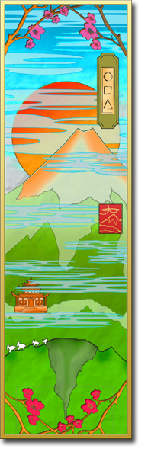On The Way: The Daily Zen Journal
The Practice of Meditation
Dogen (1200-1253)

Truth is not far away; it is ever near. Do not try to walk to it, because your every step leads away from it.
Do not follow some other person’s thoughts, but learn to listen to the voice within yourself. Your body and your mind will blend in unity, and you will realize the oneness of all life.
Even a delicate movement of your dualistic thought will prevent you from entering Samadhi, the Palace of Meditation.
Those who talk much about realization are usually wandering outside its gates and will have some struggles before they enter this Palace of Meditation.
Buddha Sakyamuni meditated six years, and Bodhidharma meditated nine years. The practice of meditation is not a method for the attainment of realization but is enlightenment itself.
Your search among books, word upon word, may lead you to the depths of the cognition world, but it is not the way to receive the reflection of your true self.
When you have thrown off your ideas as to mind and body, you will see the original person in full. Zen is nothing but the actualization of truth; therefore, the longings which are followed by actions are not the true attitude of Zen at all.
To attain the blessedness of meditation you should begin the practice with a pure motive and a firm determination. Your room for meditation must be clean and quiet. Take your regular meal sparingly and shut out all noises and disturbances. Do not let the mind dwell in thought on what is good or what is bad.

Just relax and forget that you are meditating. Do not desire to become a Buddha. If you do, you will never become one.
Sit down in a chair with a large cushion in a manner as comfortable as possible. Wear the clothing loosely, and remove your shoes, but keep your feet in a pair of warm slippers.
Put your right hand on your left thigh, palm up, and let it hold the four fingers of your left hand so that the left thumb presses lightly onto the tip of the right thumb. Hold your body straight. Lean not to the left nor the right. Do not tip forward nor bend to the back. …Keep your eyes slightly open, and breathe through your nose.

Before you begin meditation, move your body from right to left a few times, then take several slow, deep breaths. Hold your body erect, allowing your breathing to become normal again.
Many thoughts will crowd into your mind…just ignore them, and they will soon vanish. Think that which cannot be thought.

In other words, think nothing. This is the proper way to meditate according to Zen teaching.
Zen meditation is not physical culture, nor is it a method to gain something material. It is peacefulness and blessedness itself. It is the actualization of Buddha-Dharma, namely, the ultimate truth of universal oneness.
In your meditation you yourself are the mirror reflecting the solution to your problems. The human mind has absolute freedom within its true nature. You can attain your emancipation intuitively. Do not work for emancipation….but allow the work itself to be emancipation.
When you wish to return, move your body slowly and stand up quietly. Practice this meditation in the morning or in the evening, or at any leisure time during the day. You will soon realize that your mental burdens are dropping away from you one by one, and that you are gaining a sort of intuitive power hitherto unnoticed.
Do not think that the wise do not need to meditate. The wise and the dull should both take time for meditation. Constant practice of mind culture will lead anyone to the realization of truth.

In Oriental countries there have been thousands upon thousands of students who have practiced Zen meditation and obtained its fruits. Do not doubt its possibilities because of the simplicity of its method. If you cannot find the truth right where you are, where else do you expect to wander in finding it?
Life is short, and no one knows what the next moment will bring. Cultivate your mind while you have the opportunity, thereby gaining the treasures of wisdom, which in turn you can share abundantly with others, bringing them happiness.
Dogen (1200-1253)
Excerpted from Buddhism and Zen – edited, and translated by Nyogen Senzaki and Ruth Strout McCandless 1953





While Dogen can be challenging to read, this is a lovely piece that captures the heart of meditation and introduces a sitting posture in a chair that may be the first break from the traditional full lotus or Burmese position we find.
And yet, when you consider this, there are many people who physically cannot sit on the floor who may be confined to a wheelchair or due to aging just can no longer manage the cross legged or seiza position. How refreshing and so inclusive.
As with any translation, there may be phrases your mind stops on to wonder if that is what Dogen meant. We rely on our translators to capture the essence of what is in each piece, and sometimes the writing can be presented with a nuance that is shaded by the translator. In the attempt to make an ancient reading more accessible, though, we can unintentionally muddy the waters.
With practice these kinds of questions become easily resolved, and you can go with the reading, allowing for a space that cannot be easily filled. For example, “You can attain your emancipation intuitively”
Intuition is not a faculty we commonly associate with enlightenment and could serve to confuse young practitioners. However, perhaps what he is trying to express is to equate enlightenment/emancipation as a more natural state of being. Certainly we are reluctant to associate any words with this. To attempt to put any conceptual image to enlightenment is distracting.
“Life is short, and no one knows what the next moment will bring. Cultivate your mind while you have the opportunity….”
The farther along you go in practice, the more palpable is that reality. Each day is a gift along the Way.
From a clear, blue day,
Elana, Scribe for Daily Zen